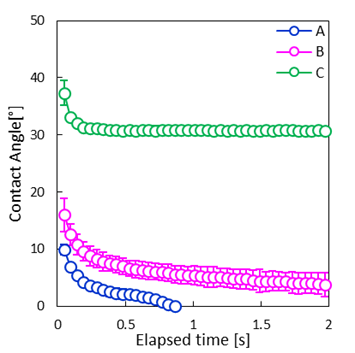Effect of flame cleaning of platinum plates when using the Wilhelmy plate method for surface tension measurements
Principle
The platinum plate must have a contact angle of 0º with the liquid sample to be measured; in other words, the liquid must completely wet the plate. If a contact angle exists, the direction of surface tension is oblique to the direction of balance detection (vertical downward), resulting in a smaller surface tension value than the liquid’s actual (true) value (Fig. 1).
𝛾 = 𝐹 / 𝐿 𝑐𝑜𝑠𝜃
𝛾 ∶ Surface tension
F ∶ Pulling force on the plate
𝐿 ∶ Perimeter of the plate
𝜃 ∶ Contact angle of the plate and the liquid

Figure 1 – Illustration of the surface tension measurement
Measurements and results
We conducted the test using our former surface tensiometer model CBVP-Z using the Wilhelmy plate method under the following conditions:
| Liquid sample: | About 30 mL of distilled water |
| Measurement probe: | Platinum (Wilhelmy) plate |
| Room temperature: | 24.8±0℃ |
| Relative humidity: | 43.0±0% |
As a result (Fig. 2 indicated in red box), the water surface tension value before the flame cleaning (2nd time) was about 9 mN/m lower than that after the cleaning (3rd time), and the error was more significant than the reference value of about 72 mN/m. From this, one can conclude that before the flame cleaning, the surface of the plate was contaminated, affecting the water contact angle and resulting in a lower surface tension.
As a result (Fig. 2 indicated on red box), the water surface tension value before the flame cleaning (2nd time) was about 9 mN/m lower than that after the cleaning (3rd time), and the error was larger than the reference value of about 72 mN/m. From this, one can conclude that before the flame cleaning, the surface of the plate was contaminated, affecting the water contact angle and resulting in a lower surface tension.

Figure 2 – Raw data of water surface tension. The red box indicates the value
obtained before and after flame cleaning the Platinum plate.
To corroborate the measured data, we measured the water contact angle of the Platinum plate with our legacy contact angle meter model DMo-501 immediately after flame cleaning (A) and after exposing it in the air for an hour (B) and a day (C). The results are shown in Fig. 3.

Figure 2 – Relation of the Platinum plate with/without flame cleaning and the water contact angle
In the case of A, the initial water contact angle was 10º, but it became 0º in less than a second, indicating its ideal state for measuring surface tension. In the case of B and C, the water contact angle of the platinum plate exposed to the atmosphere is about 5º and 30º, respectively. Hence, the surface of the platinum plates was contaminated compared to A.
Conclusion
Flame cleaning of the platinum plate is critical to avoid sample contamination and accurately measure surface tension using the Wilhelmy plate method.
Related Products


Visit our Virtual Showroom
to learn more about our company's products





